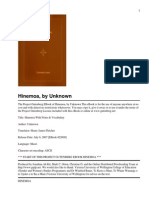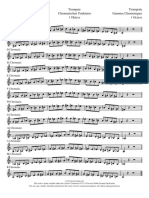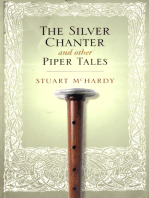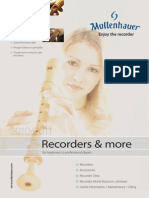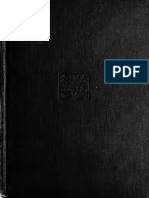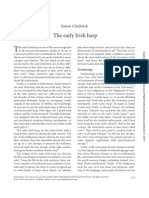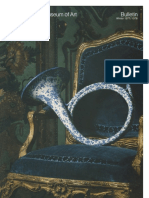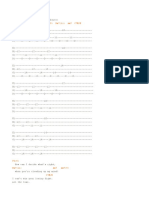The Pastoral Pipes
The Pastoral Pipes
Uploaded by
diegorojogarridoCopyright:
Available Formats
The Pastoral Pipes
The Pastoral Pipes
Uploaded by
diegorojogarridoOriginal Description:
Copyright
Available Formats
Share this document
Did you find this document useful?
Is this content inappropriate?
Copyright:
Available Formats
The Pastoral Pipes
The Pastoral Pipes
Uploaded by
diegorojogarridoCopyright:
Available Formats
This chapter is part of:
Music and the Arts
in England, c. 1670–1750
Edited by
Ina Knoth
Published by musiconn.publish, Dresden 2020
DOI: https://doi.org/10.25366/2020.112
musiconn.publish has no responsibility for the persistence or accuracy of URLs for
external or third-party internet websites referred to in this publication and does
not guarantee that any content on such websites is, or will remain, accurate or
appropriate.
The digital reproduction rights for all illustrations were either obtained by the
authors or granted by public domain licences. However, in case of suspected copy-
right infringement, please contact the editor or the publisher.
This chapter is available under a Creative Commons Attribution-NonCommercial-
ShareAlike 4.0 International (CC BY-NC-SA 4.0) licence.
Christo ph H eyl
The Pastoral Pipes
A New Musical Instrument and the Aesthetics
of Neo-Classicism
During the 1740s, musical instrument sellers in London began to offer a
new product: a sophisticated and expensive type of bagpipe suitable for
chamber music. This instrument was called “the Pastoral or New Bagpipe”.1
It could do things older types of bagpipes of the British Isles such as the
Scottish Highland bagpipes could not. It was quiet, so it could be played
together with other musical instruments. It was bellows-blown, so its reeds
were not exposed to moisture while the instrument was being played. It
therefore tended to stay in tune for much longer. Unlike mouth-blown wind
instruments, it could be played without any visible physical effort, so the
player could easily maintain a nonchalant, socially superior smile.
Older types of bagpipes tended to have a very limited compass. On these,
one could typically play not much more than nine notes, and they gave a
largely diatonic scale. This in turn limited what one could do both in terms
of viable keys and repertoire. It also limited the social settings available for
music-making. The more vociferous older types of bagpipes were appropri-
ate for open-air music-making and did not readily fit into a chamber music
scenario. For different reasons, the same was true for quieter varieties of the
instrument. Their narrowly circumscribed compass and their lack of chro-
matic versatility made them a less-than-obvious choice when it came to
playing together with, for instance, flutes, violins and keyboard instruments.
1 John Geoghegan, The Compleat Tutor for the Pastoral or New Bagpipe, London n. d. [1746
or earlier, see below].
This work is available under CC BY-NC-SA 4.0; DOI: https://doi.org/10.25366/2020.119
116 Christoph Heyl
The new instrument for which we begin to have evidence in the 1740s had
three drones fitted with single reeds. These provided a constant accompani-
ment in the shape of a permanent chord. The chanter, i. e. the pipe on which
the melody was played, had a narrow conical bore and a double reed. In
this it much resembled an eighteenth-century oboe.2 Therefore, its compass
could be extended by overblowing, and a largely chromatic scale could be
obtained by cross-fingering. On a good day and with a well-adjusted reed,
one could play two (or almost two) largely chromatic octaves. This would
have been unremarkable for a flute of the period; however, this compass
was extremely innovative and impressive for a bagpipe.
Some late-eighteenth-century instruments of this type had what was
called a regulator. This was an additional pipe stopped at the end and fit-
ted with four or five closed keys. Together with the drones, it issued from
a common stock, forming part of a bunch of pipes lying across the player’s
right knee. The regulator was positioned so that its keys could be struck
with the player’s wrist. This peculiar modus operandi for the regulator was
necessary because the player’s fingers would have been busy with the
chanter. Add to this that the bellows which were strapped to the piper’s
body needed to be worked with the right arm, pumping air into the bag
typically placed under the left arm. At the same time, the air pressure in the
bag had to be kept under control which, as in all bagpipes, required perma-
nent micro-adjustments of the left arm. Regulators (later sets of Pastoral
Pipes could have more than one) enabled the player to create a flexible
polyphony that would have been well beyond the reach of earlier bagpipes,
which had been limited to a permanent and unchanging underlying drone
chord. Now, this chord could temporally be changed by introducing another
note, creating a rudimentary but novel accompaniment that moved with
the tune that was being played.
Regulators appeared in the later eighteenth century, so this was not yet
something that the Pastoral Pipes emerging in the 1740s could do. How-
ever, even without any regulators, the key innovation provided by the new
instrument – that is the combination of the permanent drone accompani-
ment of a bagpipe with much of the flexibility and compass of the baroque
oboe – was a step forward and a step upward in musical and social terms
2 For a detailed discussion of technical aspects of the Pastoral Pipes see Hugh Cheape,
Bagpipes. A National Collection of a National Instrument, Edinburgh 2008, pp. 80–83.
This work is available under CC BY-NC-SA 4.0; DOI: https://doi.org/10.25366/2020.119
The Pastoral Pipes 117
respectively.3 It has rightly been described as an attempt to elevate this new
bagpipe into a more sophisticated and socially superior context; it was “de-
signed to make bagpipe music appeal to sophisticated and discriminating
audiences and to fit in a social and even musical context of the violin, piano
or harpsichord, flute or oboe.”4
The most important source for the early history of this new, upmarket in-
strument is a 32-page pamphlet, the Compleat Tutor for the Pastoral or New
Bagpipe by John Geoghegan.5 It was printed in London. The title-page does
not give a year of publication. A copy in the British Library has been dated
to “c. 1745”6, another in the National Museums of Scotland to “c. 1746” and
also, confusingly, “1740”.7 Seán Donelly has drawn attention to a reference
to an advertisement which would seem to suggest 1743 as the year of its
publication.8 In any case, this was “the first book of bagpipe music printed
in Britain”.9
3 The use of the bellows can also be regarded as an innovative element. Hugh Cheape
discusses the hypothesis that the pastoral pipes may have been the first bellows-blown
type of bagpipe in the British Isles. Hugh Cheape, “The Pastoral or New Bagpipe: Piping and
the Neo-Baroque”, in The Galpin Society Journal 61 (2008), pp. 285–304, p. 287. However, pain-
tings by Egbert van Heemskerck would seem to confirm the existence of bellows-blown sets
of border / lowland pipes as early as the late seventeenth century. See Paul Roberts, “The
Border Bagpipe in 17th Century Art. The First Images” in Common Stock. The Journal of the
Lowland and Border Pipers Society 28 / 2 (2011), pp. 22–34, http://lbps.net/lbps/commons-
tock/CS%20december%202011%20online%20version.pdf (last access 26 September 2020).
4 Cheape 2008, “The Pastoral or New Bagpipe”, p. 285.
5 Geoghegan n. d., Compleat Tutor; 32 pages plus frontispiece engraved title-page. Geog-
hegan’s tutor is our only early written source on the appearance of the instrument in London
and it is reasonable to infer from the nature of the instrument and the way it was marketed
that it originated in a metropolitan context. However, one must agree with Hugh Cheape that
this is of necessity an educated guess: “To date, there is no clearly discernible evidence on
where this type of instrument may have first been made or by whom, although suggestions
may be made.” Cheape 2008, Bagpipes, pp. 79–80.
6 British Library Main Catalogue, http://explore.bl.uk (last access 15 July 2020), Music Col-
lections d.47.f.(1.).
7 In the online catalogue it is described as “Book entitled ‘The Complete Tutor for the
Pastoral or New Bagpipe’, by Geoghegan, published by Simpson, London, c. 1746”, however,
in the same online catalogue entry, its date is given as “1740”. See https://www.nms.ac.uk/
explore-our-collections/collection-search-results/music-book/378086 (last access 22 May
2020), A.1947.129. Geoghegan’s Compleat Tutor went through multiple editions, the last one
was published by Clementi & Co in the early nineteenth century. For an overview building on
Roderick Cannon’s A Bibliography of Bagpipe Music, Edinburgh 1980, updated by Geoff Hore
2008–2015, see http://www.altpibroch.com/bibliography/bibliographies/union-pipes/101-2/
(last access 26 September 2020).
8 “Daily Advertiser, v. 20, Sept. ’43”. Séan Donelly, “A Publication Date for John Geoghegan’s
Compleat Tutor”, in An Píobaire 4 / 47 (2008), pp. 26–27. I am most grateful to Hugh Cheape for
pointing me to this reference.
9 Cheape 2008, “The Pastoral or New Bagpipe”, p. 289.
This work is available under CC BY-NC-SA 4.0; DOI: https://doi.org/10.25366/2020.119
118 Christoph Heyl
Geoghegan’s Tutor came with a remarkable frontispiece depicting a so-
phisticated young gentleman enjoying himself with an expensive piece of
musical equipment.10 The musician is shown in what is instantly recogniz
able as a neo-classical setting. It includes architectural props such as a bal-
ustrade and an urn just behind the musician and a little ornamental tem-
ple in the background. The vegetation depicted in this image is more than
just random greenery. It has been carefully arranged to create the visual
effect associated with English landscape gardens. Such gardens were not
just about creating an ideal landscape, but an ideal landscape of classical
antiquity. In this image, we see a bagpipe purged of any lower-class conno-
tations, a musician inhabiting a social sphere that is worlds apart from, for
instance, the piper depicted in William Hogarth’s engraving Southwark Fair
(1734).11 His instrument does not evoke any Scottish connotations the bag-
pipe may possibly have had.12 Its technical sophistication (as well as its mu-
sical sophistication emerging from Geoghegan’s Tutor) would have placed
it at a considerable distance from any vernacular traditions of piping in the
British Isles or elsewhere.
The frontispiece that came with Geoghegan’s Tutor was part of a mar-
keting strategy for a new product. Here we have a young man in a hip and
trendy neo-classical setting which suggests that the instrument must be
both hip and trendy in some neo-classical way. This bagpipe was marketed
as an instrument for affluent English (and not just English, but metropoli-
tan) amateurs. Its presentation in text and image was consistent with the lo-
cation of the music shop where this booklet was sold and where one could
also buy such a bagpipe. The shop was situated “in Sweetings Alley opposite
ye East Door of the Royal Exchange”.13
In his preface, Geoghegan is at pains to point out the versatility of this
new type of bagpipe. At a time when the Pastoral Pipes had become silent
10 The author is most grateful to Ross Anderson for making a high-resolution scan of
Geoghegan’s frontispiece available. This image can also be seen on his website, https://www.
cl.cam.ac.uk/~rja14/music/index.html (last access 14 June 2020), along with a complete scan
of Geoghegan’s Tutor.
11 For a reproduction, see https://www.metmuseum.org/art/collection/search/400729 (last
access 23 May 2020).
12 This would seem to strengthen the case for a date of publication before the Jacobite
rising of 1745. However, we cannot be sure at all that there would have been a dominant per-
ception of the bagpipes as “Scottish” in the 1740s. After all, this was long before the Highland
bagpipes came to be regarded in the nineteenth century as the dominant and iconic embo-
diment of the instrument.
13 Geoghegan n. d., Compleat Tutor, title-page.
This work is available under CC BY-NC-SA 4.0; DOI: https://doi.org/10.25366/2020.119
Figure 7.1: John Geoghegan, The Compleat Tutor for the Pastoral or New Bagpipe, London n. d.,
frontispiece; courtesy of Ross Anderson
This work is available under CC BY-NC-SA 4.0; DOI: https://doi.org/10.25366/2020.119
120 Christoph Heyl
exhibits in museums, the claims he made for the new instrument, espe-
cially regarding its extended compass, were regarded with a great deal of
scepticism. However, in recent years there has been a tentative revival of
the instrument. A small number of antique Pastoral Pipes have been made
playable again and several bagpipe makers have taken an interest in what
had been a musical fossil. Today, aspiring players can once again purchase
Pastoral Pipes modelled on period instruments. The resulting experimen-
tation with old and new Pastoral Pipes has shown that the instrument is
indeed capable of playing the music provided in Geoghegan’s tutor.14
Geoghegan emphasizes not only the new bagpipe’s versatility but also its
respectability. In his text, the instrument’s technical sophistication and the
player’s social sophistication go together:
The Bagpipe being at this Time brought to such Perfection as now renders it able
to perform ye same Number of Notes with ye Flute or Hautboy, I thought it might
be acceptable to the Curious to set forth this small Treatise […]. I have known
some young Gentlemen, Who had not only a fine Taste for all sorts of Musick,
but also a fine Genius, to have a great Desire to play the Bagpipe, yet have been
hindered from what their Inclinations so urged them to, by this Instrument’s
wanting a Scale or Gamut to learn by, which all other Musical Instruments of any
Value have.15
He employs an elevated register (“Treatise”, “acceptable to the Curious”,
“Gentlemen”, “fine Taste”, “fine Genius”) to good effect. He also makes it
clear that this is an instrument for music-literate players, that it positively
demands the sort of elite knowledge that makes any cultural practice a
mark of social distinction. Then, he helps to fashion an identity for this new
instrument by associating it with the idea of something much older:
Those of good Genius who are dispos’d to play this Instrument may be able to
improve the Musick of it very much beyond what at present it is. – I flatter myself
14 A great deal of very practical research has been done by Ross Anderson, who owns
two playable antique sets of Pastoral Pipes. An assessment of the instrument’s capabilities
and a wealth of additional material relating to it can be found on Ross Anderson’s website:
https://www.cl.cam.ac.uk/~rja14/music/index.html (last access 4 June 2020). Anderson owns
and plays two antique sets of Pastoral Pipes. The author of this paper can also attest to the
instrument’s musical potential – he plays both an antique set and a modern one made by
Jon Swayne (both illustrated in this paper).
15 Geoghegan n. d., Compleat Tutor, p. 1.
This work is available under CC BY-NC-SA 4.0; DOI: https://doi.org/10.25366/2020.119
The Pastoral Pipes 121
this Treatise will not be unacceptable to ye Professers of this antient pastoral
Musick or to ye Makers of the Instrument […].16
To an educated reader of the period, the phrase “antient pastoral Musick”
would have evoked notions of pastoral life as found in bucolic poetry. The
interest in bucolic poetry was part and parcel of the neo-classicism that
was so much en vogue at the time. Neo-classical English poems evoking the
lives and loves of shepherds were just as artificial as English landscape gar-
dening. In creating ideal rural scenarios, they were both essentially urban
phenomena. They can both be understood as reactions to the affluent city
dweller’s nostalgia for the rural life that never was, as well as a readiness
to embrace the cachet offered by the trimmings of classical erudition. As
London’s growth accelerated dramatically in the course of the eighteenth
century and the spending power and cultural aspirations of the middle clas-
ses grew, more and more people would have been ready to buy into this
particular type of nostalgia. Both the frontispiece and the preface of Geog-
hegan’s Compleat Tutor appeal to this desire.
In bucolic poetry, shepherds often play what poets liked to call the “oa-
ten reed”. This very simple instrument was still being made and played in
the eighteenth century. The “oaten reed” was technically a primitive clarinet.
It could easily be fashioned from a suitable bit of straw which provided a
natural cylindrical bore. Its sound was produced by an idioglot single reed
cut out of the body of the straw. Preparing the tongue and cutting some
fingerholes would only have taken a few minutes, resulting in a simple but
instantly playable little wind instrument. This form of pipe was readily avail-
able in a rural setting – an actual pastoral pipe, a homemade instrument of
the utmost simplicity that cost nothing at all.17
The instrument Geoghegan chose to call “the Pastoral Bagpipe” could
not have been further away from all this.18 His strategic use of the word
“Pastoral” allowed him to play the card of classicism, to evoke the sort of
bucolic nostalgia that would have appealed to the metropolitan milieu of
16 Ibid.
17 The author of this paper has often made such pipes and can therefore attest to the utter
simplicity of the process.
18 We cannot be sure who first came up with this name. However, as Geoghegan was so
adept at promoting the new instrument, I entirely agree with Hugh Cheape who thinks that
he may well have been “the sole begetter” of this idea. Cheape 2008, „The Pastoral or New
Bagpipe“, p. 289.
This work is available under CC BY-NC-SA 4.0; DOI: https://doi.org/10.25366/2020.119
122 Christoph Heyl
privileged and educated young gentlemen. However, at the same time, all
of this was daringly counterfactual. In spite of the simplicity suggested by
the word “pastoral”, which suggested something akin to the simple straw
instrument, everything about the new bagpipe was modern, high-tech and
therefore expensive. The innovative nature of the instrument, with its com-
bination of bellows and an oboe-type chanter designed to overblow and
produce a largely chromatic scale, cannot be stressed enough. Making such
an instrument required considerable skill and expertise in many fields, in-
cluding metalwork. The instrument was often rendered more compact by
making its very long bass drone do a double u-turn. For the u-turn sections,
short lengths of metal tubing had to be bent; a difficult task which required
the mastery of techniques employed in the manufacture of brass instru-
ments. A further, entirely different set of leatherworking skills was required
for making bellows and bags. Perhaps the greatest difficulty lay in making
the reeds, both the single reeds for the drones and even more so the double
reed for the chanter. We know from experience with restored instruments
and modern copies that chanter reeds suitable for the Pastoral Pipes are
extremely delicate, and that they can be temperamental. They had to be
precisely adjusted so as to respond to an increase in air pressure by going
into the second octave.19 The chanter reed was both high-tech and poten-
tially high-maintenance.
In terms of the materials used, the Pastoral Pipes can be described as the
product of an economy that was both internationalised and increasingly im-
perial. While older, vernacular traditions of pipe making in the British Isles
had made use of native hardwoods and horn (for the decorative mounts),
the instrument described by Geoghegan was a luxury item that tended to be
fashioned from luxury materials. Surviving instruments from the eighteenth
and early nineteenth century were made not only of boxwood, but also of
tropical hardwoods. Domestic supplies of boxwood, which was commonly
19 An oboe reed can be manipulated by the player. As it is held between the player’s lips,
micro-adjustments in pressure can be made which greatly facilitate the transition between
the first and the second octave. A chanter reed for the Pastoral Pipes needs to be set up
to achieve this transition automatically, just responding to an increase in air pressure. Ma-
king reeds, and especially chanter reeds, presents the greatest challenge when it comes to
making antique sets of Pastoral Pipes playable again. Some of the difficulties that will be
encountered are vividly described by Dave Singleton, “Pastoral pipes – Can It [sic!] Find a pla-
ce in 2016”, in Common Stock 33 / 1 (2016), https://lbps.net/j3site/index.php/common-stock/
archive-issues/138-june-2016/823-pastoral-pipes-can-it-find-a-place-in-2016 (last access 26
September 2020).
This work is available under CC BY-NC-SA 4.0; DOI: https://doi.org/10.25366/2020.119
Figure 7.2: Antique Pastoral Pipes with one regulator, no maker’s mark, perhaps made in Edin-
burgh or Northumbria, c. 1800–1820?; author’s collection
Figure 7.3: Pastoral Pipes made by Jon Swayne, Baltonsborough, 2017, modelled on a late-
eighteenth century instrument by Hugh Robertson, Edinburgh; author’s collection
This work is available under CC BY-NC-SA 4.0; DOI: https://doi.org/10.25366/2020.119
124 Christoph Heyl
used in quality woodwind instruments such as flutes, were limited. It was
therefore also imported from the Mediterranean, especially from the core
of the Ottoman Empire.20 Tropical hardwoods from Africa and the Caribbean
became increasingly available and fashionable. These dark-coloured woods
were dense and heavy, which affected not only their sound. They were also
set apart by their very distinctive visual and haptic appeal. Such woods
could be polished to a beautiful lustre, and their weight suggested solidity
and value. All of this would have mattered to the style-conscious young men
who might have considered taking up a new musical hobby.
Many, probably even most sets of Pastoral Pipes were fitted with decora-
tive mounts and finials made of ivory, the bulk of which would have come
from West Africa.21 Here, makers followed the aesthetics developed in other
branches of fine woodwind instrument-making. The material value and the
visual appeal of Pastoral Pipes could be further increased by dispensing
with wooden parts altogether. There is a particularly splendid set of Pastoral
Pipes in the St Cecilia’s Hall collection (Edinburgh) which is made entirely
of ivory.22
On the one hand, the Pastoral Pipes were meant to appeal to a neo-
classical nostalgia for a simple pastoral world that never was. On the other
hand, it appealed to a metropolitan target group of affluent young men who
were highly style-conscious and who loved the latest high-tech gadgets. It
offered the best of both worlds and the naming of the instrument – both
“pastoral” and “new” – was an inspired marketing strategy.
The Pastoral Pipes were meant to bring the bagpipes into the realm of
polite middle-class music-making. Geoghegan’s tutor provided not only in-
structions on how to play the instrument but also a concise introduction
to reading music for those that were not yet music-literate. There are para-
20 We find boxwood in a list of goods exported from the Ottoman Empire during the eight-
eenth century that were subject to an export fee (masdariye). See R. Murphy, “Conditions of
Trade in the Eastern Mediterranean. An Appraisal of Eighteenth-Century Ottoman Documents
from Aleppo”, in Journal of the Economic and Social History of the Orient 33 / 1 (1990), pp. 35–
50, p. 41.
21 See Harvey M. Feinberg and Marion Johnson, “The West African Ivory Trade during the
Eighteenth Century: The ‘… and Ivory’ Complex”, in The International Journal of African Histori-
cal Studies 15 / 3 (1982), pp. 435–453. Indian Ivory would have been less commonly available in
eighteenth-century England as the ships of the East India Company took most of it to China.
So-called marine ivory (i. e. mostly walrus ivory) would have been another choice. It seems
to have been less popular with makers of luxury woodwind instruments including Pastoral
Pipes. Its appearance is not as smooth and white as that of elephant ivory.
22 https://collections.ed.ac.uk/stcecilias/record/99203 (last access 22 June 2020).
This work is available under CC BY-NC-SA 4.0; DOI: https://doi.org/10.25366/2020.119
The Pastoral Pipes 125
graphs entitled “Of Flats and Sharps”, “Of the Cadences or Shakes”, “Of Pricks,
Rests, and Pauses in Music” and “Of Tyed Notes”.23 In this, the tutor followed
the basic conventions of the genre. Tutor books for absolute beginners fre-
quently contained a section on how to read music. Being able to read music
rather than learning by ear was a cultural practice that was very much at
the heart of polite music-making. It was therefore also a social marker. As-
sociating the new bagpipe firmly with this type of practice served to elevate
it from older traditions of piping. Here the text once again moves very much
in tandem with the frontispiece. Players of the Pastoral Pipes are envisaged
as music-literate gentlemen (which includes those willing to brush up their
skills or to build them up from scratch). They inhabit a world that is, both in
social and in musical terms, meant to be far removed from that of a piper
such as the itinerant street musician depicted in Hogarth’s Southwark Fair.
Geoghegan’s pamphlet also contained an appendix with a rather grand
title: “A DICTIONARY Explaining such Greek, Latin, Italian and French words
as generally occur in Musick”. The somewhat grandiloquent use of the term
“dictionary” for something that filled just one page (!) was more to do with
aspirations than with realities. However, in England, and especially in Lon-
don, aspirations could lead to new realities. There was a degree of social
mobility that would have been unthinkable in most continental societies of
the period. Of course, it was still best to be born a gentleman, but this status
could also be attained by means of social emulation. The way of becoming
a gentleman was to acquire the cultural habitus of the gentleman. Owning
a luxury musical instrument and acquiring skills based on music literacy
could be part of this strategy. Genteel music-making was associated with
elite sociability. Being able to play a musical instrument compatible with
others such as the flute or the violin gave the player a chance to become
part of social networks that could substantially facilitate social climbing.
Mastering elite linguistic codes and being able to hold one’s own in po-
lite conversation (here: in conversation about music) would also have been
helpful. No privileged young man who had had the benefit of a classical
education would really have had much use for a one-page “Dictionary” pro-
mising to explain Greek and Latin words occurring in music – all the more
so as Greek and Latin were in fact conspicuously absent from this list, which
entirely consisted of Italian terms. Likewise, no young man who had been
23 Geoghegan n. d., Compleat Tutor, pp. 6–8.
This work is available under CC BY-NC-SA 4.0; DOI: https://doi.org/10.25366/2020.119
126 Christoph Heyl
fortunate enough to have done the grand tour and who was of a musical
bent would have needed such a list of “Italian and French words” as he
would probably have known most of them anyway. (And by the way, “French”
was another empty promise here.) As far as this section of the readership
was concerned, the presence of the “Dictionary” was symbolic rather than
functional. Its purpose was not to convey information but to reassure and
to signal respectability. However, for those less fortunate who had never
been to university or done the grand tour, this elementary crib could be
of some practical value. Social climbing by means of social emulation very
much required linguistic emulation, and a smattering of impressive words
was better than nothing at all. What is more, the mere token presence of
the words “Greek” and “Latin” chimed in with the theme of Neo-Classicism
evoked in both the frontispiece and the text with a view to bolstering the
status of the new bagpipe.
Geoghegan’s tutor was one of several very similar instructional pamph
lets published by John Simpson in the 1740s. There was, for instance, a Com-
pleat Tutor for the French Horn. Comparing its engraved title-page with that
of the Compleat Tutor for the Pastoral or New Bagpipe,24 it becomes imme-
diately clear that the layout and design of the title pages is identical, inclu-
ding words such as “The Compleat Tutor for the […] Containing […]” as well
as the precise shape of all the decorative flourishes surrounding them. It is
likely that the engraved title-pages for the entire series were printed using
one and the same copper plate, which could be adapted for each pamphlet
by hammering out and then re-engraving individual names of instruments
and other words as required. This would also explain the enigmatic ab-
sence of the year of publication from the title-page: a sufficient supply of
undated title-pages could be printed and stored for use with later editions
of the pamphlet. This guaranteed the visual uniformity of a whole series of
different tutor books sold in Simpson’s shop, while avoiding the impression
of ever selling anything that was not brand-new. Thus, the pamphlet on
how to play the “Pastoral or New Bagpipe” would itself appear new for years
to come, which was a good thing as Simpson catered to customers valuing
novelty.
24 [Anon.], The Compleat Tutor for the French Horn Containing The Best and Easiest Instruc-
tions for Learners to Obtain a Proficiency […], London n. d.. For a scan, see https://imslp.org/
wiki/The_Compleat_Tutor_for_the_French_Horn_(Anonymous) (last access 4 June 2020).
This work is available under CC BY-NC-SA 4.0; DOI: https://doi.org/10.25366/2020.119
The Pastoral Pipes 127
The horn tutor published by Simpson also came with a frontispiece de-
picting a player of the instrument and the one-page “Dictionary” found in
Geoghegan’s bagpipe tutor. “Compleat Tutors” for the Harpsichord and the
Flute, also published by Simpson, are listed in the British Library catalogue.25
Geoghegan’s tutor stands out from other very similar offerings available
from Simpson’s shop in one respect: In this case, the author’s name is given.
Otherwise it conforms to an established type. It would therefore have been
perceived as a respectable tutor belonging to an entire class of other re-
spectable tutors. The instrument was thus presented as a respectable bag-
pipe that would not have seemed to be out of place among other respect-
able instruments, and therefore as a viable and tempting choice for those
who were interested in polite music-making but also in forms of sociability
that went with it.
The Pastoral Pipes became fashionable among well-to-do amateurs, and
they remained so well into the early nineteenth century. Although we find
the earliest evidence for them in London, they were soon also made in
Edinburgh and Dublin. What about the musical practice associated with the
instrument? Geoghegan’s tutor, which is once again our key source for the
early history of the instrument and its music, gives a basic repertoire of 41
tunes drawn from a variety of musical idioms. There are short English, Scot-
tish and Irish tunes, the kind of material that would probably be classified
as traditional music today. Here we have pieces such as “Portsmouth Har-
bour”, “A Highland Rant” or “The Humours of Westmeath”.26 Scottish music
was popular in England.27 If the tutor was indeed published before the Ja-
cobite rising of 1745, its Scottish tunes would not have given offence at all,
and, at any rate, the popularity of Scottish music in England survived this
political upheaval remarkably well.28
25 [Anon.], The Compleat Tutor for the Harpsichord or Spinnet wherein is shewn the Italian
Manner of Fingering, London n. d., “c. 1745” according to the British Library Main Catalogue;
[Anon.], The Compleat Tutor for the German Flute, containing the best and easiest instruc-
tions for learners to obtain a proficiency, London n. d., “1746?” according to the British Library
Main Catalogue.
26 Geoghegan n. d., Compleat Tutor, pp. 27, 14, 18.
27 For a concise account of its popularity especially in London, see Cheape 2008, Bagpipes,
p. 89.
28 Simpson also published an edition of James Oswald’s Caledonian Pocket Companion, 6
vols. This edition is not dated; the catalogue of the National Library of Scotland dates it to
1745–1760. It contains Jacobite tunes such as “There are few good Fellows when Jamie’s awa’”
or “The King shall enjoy”, which would have been instantly recognizable as “The King shall
enjoy his own again”, or “Over the water to Charlie” (The Caledonian Pocket Companion, Lon-
This work is available under CC BY-NC-SA 4.0; DOI: https://doi.org/10.25366/2020.119
128 Christoph Heyl
Sometimes Geoghegan’s titles can be misleading. A piece he called “A
Scotch Measure”29 was in fact a version of “O’ Carolan’s Receipt for Drink-
ing”, a tune composed by the famous blind Irish harper Turlough O’Carolan
(1670–1738).30 O’Carolan was influenced by the Italian baroque style, which
shows in this particular tune. There is also an extraordinary piece entitled “A
Bagpipe Concerto call’d the Battle of Aghrem, or the Football Match”.31
Geoghegan’s basic repertoire for the Pastoral Pipes also includes pieces in
a very different idiom. There is a composition by or associated with the early
seventeenth-century composer Thomas Ravenscroft, “Ravenscroft’s Fancy”.32
There is also a piece entitled “With early Horn”, an instrumental version of
a bravura aria from the popular Covent Garden pantomime The Royal Chace
(1736).33 This is a fearsomely challenging piece emulating the human voice
trained in the operatic tradition. It would have been well outside the range
of anything that was doable and indeed thinkable in any vernacular tradi-
tion of piping in the British Isles at the time. The author of this paper can
confirm that “The Royal Chace” can indeed be played on the Pastoral Pipes
– it does demand a considerable effort, but it is entirely possible to get there
eventually.
“The Royal Chace” was a glittering showpiece. As such, it substantiated
Geoghegan’s implicit claim that the Pastoral Pipes could indeed go where
no other bagpipe in the British Isles had gone before. It legitimated this
new type of bagpipe as a social climber. “The Royal Chace” also points to
a connection between the Pastoral Pipes and the stage. The instrument
don n. d., vol. 1, p. 20, vol. 2, p. 20 and vol. 3, p. 7). Incidentally, we can see very similar strategies
at work in the development of the Pastoral Pipes and the arrangement of the tunes found in
Oswald’s Caledonian Pocket Companion. Oswald’s Scottish tunes came with variations hea-
vily influenced by baroque convention. In both cases, elements of technical sophistication
were introduced to make a product associated with the ideas of simplicity and tradition more
palatable to an elite group of metropolitan customers.
29 Geoghegan n. d., Compleat Tutor, p. 10.
30 Cf. Francis O’Neill (ed.), O’Neill’s Music of Ireland. Eighteen Hundred and Fifty Melodies.
Airs, Jigs, Reels, Hornpipes, Long Dances, Marches etc., Many of which are now Published
for the First Time. Collected from all available Sources, Chicago 1903, p. 113. For continen-
tal influences on O’Carolan, see Breandán Ó Madagáin, “Carolan, Turlough (Toirdhealbhach
Ó Cearbhalláin)”, in Oxford Dictionary of National Biography, 2004, https://doi.org/10.1093/
ref:odnb/20484 (last access 4 June 2020).
31 Geoghegan n. d., Compleat Tutor, p. 16. Hugh Cheape’s reading of this piece is intriguing:
“It must also represent a residual form of piobaireachd music surviving in Ireland.” Cheape
2008, Bagpipes, p. 86.
32 Geoghegan n. d., Compleat Tutor, p. 14.
33 For more information on The Royal Chace, see Ian Bartlett and Robert J. Bruce, William
Boyce. A Tercentenary Sourcebook and Compendium, Newcastle upon Tyne 2011, p. 176.
This work is available under CC BY-NC-SA 4.0; DOI: https://doi.org/10.25366/2020.119
The Pastoral Pipes 129
would have been capable of accompanying ballad operas, secular canta-
tas and such like, for instance Allan Ramsay’s Gentle Shepherd (1725), John
Gay’s Beggar’s Opera (1728) and Love and Liberty, a Cantata (1785) by Robert
Burns, all of which used “traditional” tunes.34 Although such a connection is
more than plausible, there is no hard evidence for any of this. However, it
is worth remembering that absence of evidence is not to be confused with
evidence of absence. One may also assume that the Pastoral Pipes would
have been used in the more raucous contexts of musical entertainments in
gentlemen’s clubs and other informal gatherings.
The instrument underwent further development, and a modified variant
of it acquired a new name. This modification came about by shortening the
chanter. The first step towards this was probably to take off the chanter’s
foot, the segment that had vent holes that always remained open. Without
the foot, the chanter could be stopped on the player’s thigh. Thus, a stac-
cato effect could be achieved. From the 1790s, people increasingly talked
about such instruments with a short, that is, footless chanter as the Union
Pipes. There is one hypothesis saying that “Union” refers to the complexity
of the instrument, to its union of components and sounds. There is another
saying that this might have referred to the political union of the Crown.35
To begin with, the new instrument had been meant to appeal to a sense
of neo-classical pastoral nostalgia. Other nostalgias and modes of self-fa-
shioning followed. As the second half of the eighteenth century progressed,
the pastoral past acquired a new meaning. It also came to be thought of as
a past located in the pre-industrial British Isles. It could thus become part
of a Romantic rather than a neo-classical nostalgia.
The instrument was used in theatrical representations of Scottishness.
In 1791, the English actor and composer William Reeve wrote a piece called
The Grand Pantomime Ballet of Oscar and Malvina, which was produced at
34 One tune in Ramsay’s The Gentle Shepherd, “Sang XVII. Tweed-side” (Allan Ramsay, The
Gentle Shepherd: A Scots Pastoral Comedy, Glasgow 1758, p. 83) is also found in Geoghegan’s
Compleat Tutor (p. 11), which may or may not indicate a connection. In the absence of reliable
and substantial sources, we are left with what, at best, may be tantalizing hints.
35 Sarah Deters in Arnold Myers (ed.), Catalogue of the Edinburgh University Collection of
Historic Musical Instruments, vol. 2, Part G: Bagpipes, Edinburgh 2013, p. viii. The instrument’s
name was used as a political allusion in a cartoon by William Dent entitled A Scotch Reel,
or Sawny’s Jofull Turn into Office (1793, published by James Aitken). Here William Pitt is seen
playing a bagpipe (mouth-blown, drones held in a common stock, transparent bag half filled
with gold coins), with the words “UNION PIPES” on its bag. There is a copy of this print in
the British Museum (accession number: 1948,0214.453), see https://www.britishmuseum.org/
collection/object/P_1948-0214-453 (last access 20 November 2020).
This work is available under CC BY-NC-SA 4.0; DOI: https://doi.org/10.25366/2020.119
130 Christoph Heyl
Covent Garden.36 Its subject matter was drawn from James Macpherson’s
Ossianic poems. Oscar and Malvina had it all – sublime nature, love interest,
Highland games and a grand battle scene. It was hugely successful for the
next 25 years or so. The instrument was used to give the music of Oscar and
Malvina a Scottish flavour.37 In this case, we are very much looking at union-
ist stage Scottishness concocted for a Covent Garden audience.
The Pastoral or Union Pipes acquired associations of Scottishness out-
side Scotland. Two manuscript collections dating from the eighteenth and
early nineteenth century suggest that in Scotland, a repertoire of predo-
minantly Scottish tunes was played on the Pastoral Pipes.38 However, from
the early nineteenth century, yet another re-fashioning of the instrument’s
identity was already under way. The instrument was now increasingly asso-
ciated with Ireland and Irish music.
Patrick O’Farrell, the piper who performed in early nineteenth-century
Covent Garden productions of Oscar and Malvina, published a collection of
music for his instrument c. 1804. Its title was O’Farrell’s Collection of Natio-
nal Irish Music for the Union Pipes.39 On the title-page, we find a rather in-
teresting little vignette with a portrait of O’Farrell that indicates clearly that
we are in a transitional phase regarding the perception of the instrument.
It depicts, as it says underneath the portrait, “O’Farrell playing the Union
Pipes in the Favorite Pantomime of Oscar & Malvina”. The piper is “dressed
as a stage Highlander”40. However, one unusual feature has been added to
his cliché Scottish outfit. Three huge feathers attached to his cap form a
highly conspicuous element of his costume. These would immediately have
36 For a detailed account, see Cheape 2008, Bagpipes, pp. 113–116. Libretto: [Anon.], The
Airs, Duets, Choruses and Argument of the New Ballet Pantomime (Taken From Ossian) Calles
Oscar and Malvina; Or, The Hall of Fingal. As Performed at the Theatre-Royal, Covent-Garden,
London 1791.
37 There is a score entitled “Overture to Oscar and Malvina, with the Highland March &
Battle Pieces. Composed by Mr. Reeve”, see scan in the Lester S. Levy Sheet Music Collec-
tion, Johns Hopkins Sheridan Libraries & University Museums, https://levysheetmusic.mse.
jhu.edu/collection/015/095 (last access 15 June 2020). The Rondo was originally played on the
Union Pipes and the Harp “(Mr. Meyer)”, see ibid., p. [4].
38 See Cheape 2008, Bagpipes, p. 100. A very useful overview along with scans of several
manuscripts and articles by Ross Anderson can be found on his website: https://www.cl.cam.
ac.uk/~rja14/music/index.html (last access 14 June 2020).
39 [Patrick O’Farrell], O’Farrell’s Collection of National Irish Music for the Union Pipes, Lon-
don n. d.
40 Cheape 2008, Bagpipes, p. 104, where a reproduction of this detail can also be found. A
scan of the entire title-page (from the copy held in Yale University Library) can be found here:
http://digital.library.yale.edu/cdm/ref/collection/1027_2/id/18 (last access 14 June 2020).
This work is available under CC BY-NC-SA 4.0; DOI: https://doi.org/10.25366/2020.119
The Pastoral Pipes 131
been recognized by Regency audiences as the Prince of Wales’s feathers, the
heraldic badge of the Prince of Wales.
The three feathers may have been stuck in O’Farrell’s cap for a number of
reasons. Everything connected with the prince was regarded as fashionable.
Adding the feathers might have been an attempt at currying favour with the
Prince in person as he was an habitué of Covent Garden. At any rate, the
conspicuous use of this royal badge on stage was a useful indicator of loyal-
ty to the Crown during the time of the Napoleonic Wars. It was a visual equi-
valent of the loyal toast that became mandatory at all sorts of gatherings.
All in all, the title-page of O’Farrell’s Collection of National Irish Music for
the Union Pipes indicates clearly that we are entering a transitional phase in
the perception of the instrument. It combines notions of Irishness (National
Irish Music) and Scottishness (the stage Scot in an Ossianic pantomime)
with an indication of loyalty to the crown providing a unionist umbrella. One
can see why the instrument’s name at the time, “Union Pipes”, whatever its
origins may have been, could have been read as a reference to the Union
and therefore as politically charged.
In a subsequent publication, O’Farrell called his instrument not just the
Union pipes but, right on the title-page “[…] the Irish or Union pipes […]”.41
The newly acquired Irishness of this expensive, high-tech instrument of
course meant “Irish” as in affluent, Protestant and therefore Unionist.
This was the state of affairs in the early nineteenth century. In the Victo-
rian period, the Pastoral Pipes and their later incarnation, the Union Pipes,
disappeared first in England and then in Scotland. In Scotland they were
elbowed aside by the Highland bagpipes which were adopted by the army.
As Hugh Cheape has pointed out, by the mid-nineteenth century the Pas-
toral Pipes had totally dropped out of the narrative of English and Scottish
music-making, and much the same happened to the instrument in the guise
of the Union Pipes.42 In Ireland, the instrument gradually lost its upmar-
ket status. It was increasingly played by poor Catholic musicians for poor
Catholic audiences. The bagpipe invented for gentlemen became a bagpipe
played by paupers. In the context of the Celtic revival in Ireland, it was just
41 [Patrick O’Farrell], O Farrels, [sic!] Pocket Companion for the Irish or Union Pipes, Being
a Grand Collection of Favourite Tunes both Scotch and Irish, adapted for the Pipes, Flute, Fla-
geolet and Violin, 4 vols., London n. d., “possibly between about 1805 and 1811” according to
Cheape, Bagpipes, p. 112.
42 Cheape 2008, Bagpipes, pp. 100, 120.
This work is available under CC BY-NC-SA 4.0; DOI: https://doi.org/10.25366/2020.119
132 Christoph Heyl
about kept alive by a small number of affluent gentlemen players taking
an interest in it. Promoting the pipes became part of the agenda of Irish
cultural nationalism.
This led to yet another re-naming of the instrument. As the term “Union”
was odious from an Irish pro-Home Rule perspective, it is not altogether
surprising that a new Gaelic term was popularized in 1911 by Grattan Flood,
an Irish musicologist.43 Now they were called “uilleann pipes”, i. e. elbow
pipes, as the bellows were placed under the player’s elbow. This linguistic
camouflage, together with inflated claims of antiquity, helped to obliterate
the earlier history of this bagpipe. It came to be regarded as an indigenous,
traditional Irish instrument. Its documented early history in London and its
initial associations with neo-classicism and English metropolitan elite cul-
ture were conveniently forgotten.
Thus, we see this peculiar type of bagpipe as a signifier that was time
and again re-inscribed with meaning, with new social, cultural and political
connotations: from neo-classicism via Scottish and Irish unionism to Irish
cultural nationalism. The changing fortunes of this remarkable bagpipe tur-
ned it into an ideological chameleon.
43 “The fact is that there were two classes of Irish bagpipes – the piob mor and the Uilleann
pipes, the latter of which came into vogue about the year 1588. […] Curiously enough, the Irish
name of the domestic Irish pipes has in more recent times been corrupted to ‘union’ […].”
William Henry Grattan Flood, The Story of the Bagpipe, London and New York 1911, p. 95. Note
the inversion of the development from “union” to “uilleann”.
This work is available under CC BY-NC-SA 4.0; DOI: https://doi.org/10.25366/2020.119
You might also like
- Eckstein Piano Course-Book One09052020160455Document31 pagesEckstein Piano Course-Book One09052020160455Hakan Dutar100% (1)
- A History of Irish MusicDocument158 pagesA History of Irish MusicLuiz Ricardo PaulukNo ratings yet
- Kinnaird Bagpipes - Piping SuperstitionsDocument1 pageKinnaird Bagpipes - Piping SuperstitionsRauncie KinnairdNo ratings yet
- Illustrated Catalogue C. Bruno & SonDocument40 pagesIllustrated Catalogue C. Bruno & Sonkoutetsu0% (1)
- Hinemoa, by UnknownDocument25 pagesHinemoa, by Unknownbalraj5926No ratings yet
- Discography July 2017 PDFDocument254 pagesDiscography July 2017 PDFRaphaelBrownleeNo ratings yet
- La Traviata - Opera Classics LibraryDocument112 pagesLa Traviata - Opera Classics LibraryIvan Hockley100% (3)
- Ibanez Echo Shifter Schematic: Read/DownloadDocument3 pagesIbanez Echo Shifter Schematic: Read/DownloadTia WIlliams40% (1)
- Chromatic Scales - Trumpet - LexcerptsDocument3 pagesChromatic Scales - Trumpet - LexcerptsLexcerptsNo ratings yet
- The Pipers' Guild Handbook - The Origin and History of the Pipe Movement with Instructions on How to make Pipes with DiagramsFrom EverandThe Pipers' Guild Handbook - The Origin and History of the Pipe Movement with Instructions on How to make Pipes with DiagramsNo ratings yet
- Constructing A Kongo Identity - Scholarship and MythopoesisDocument23 pagesConstructing A Kongo Identity - Scholarship and MythopoesisfabricegiaNo ratings yet
- William Kennedy Piping FestivalDocument11 pagesWilliam Kennedy Piping FestivalThe Journal of MusicNo ratings yet
- DUNNAVANT, Justin. 2020. Have Confidence in The Sea - Maritima Maroons and Fugitive GeographiesDocument22 pagesDUNNAVANT, Justin. 2020. Have Confidence in The Sea - Maritima Maroons and Fugitive GeographiesLuis Felipe FreireNo ratings yet
- Chord Chart KalimbaDocument1 pageChord Chart KalimbaAlucard MasterNo ratings yet
- Chanter - Summer 2017Document68 pagesChanter - Summer 2017Manolo Vazquez PerezNo ratings yet
- East Ulster DictionaryDocument138 pagesEast Ulster DictionaryhiroNo ratings yet
- Bagpipe in ItalyDocument8 pagesBagpipe in ItalyAntonio BaianoNo ratings yet
- Athena Patterson-Orazem Dreams in VodouDocument4 pagesAthena Patterson-Orazem Dreams in VodouRob ThuhuNo ratings yet
- Patterns of Nsenga Kalimba Music by John BlackingDocument19 pagesPatterns of Nsenga Kalimba Music by John Blackingberimbau8100% (1)
- Imaginary Dialogs Pt. III BríkamoDocument20 pagesImaginary Dialogs Pt. III Bríkamoguarachon63100% (3)
- Balfour Henry The Old British Pibcorn or HornDocument16 pagesBalfour Henry The Old British Pibcorn or HornИгнаций ЛойолаNo ratings yet
- Bagpipe Playing - Canntaireachd - Articulate Music - J. F. Campbell - 1880Document58 pagesBagpipe Playing - Canntaireachd - Articulate Music - J. F. Campbell - 1880Kintyre On Record100% (1)
- Barbara Hepworth Teachers' Resource Pack: PelagosDocument23 pagesBarbara Hepworth Teachers' Resource Pack: PelagosElma FrancoNo ratings yet
- O'Mealy ReamersDocument13 pagesO'Mealy ReamersRusty_Iron_WorksNo ratings yet
- 10 Cambridge Recorder Players Pre XXDocument7 pages10 Cambridge Recorder Players Pre XXSophia KwiatkowskiNo ratings yet
- EG Chapter 1 Excerpt 2 PDFDocument6 pagesEG Chapter 1 Excerpt 2 PDFjuanNo ratings yet
- YdwutcyiDocument3 pagesYdwutcyiOskar ReyntjensNo ratings yet
- Folklore Enterprises, Ltd. and Taylor & Francis, Ltd. Are Collaborating With JSTOR To Digitize, Preserve andDocument21 pagesFolklore Enterprises, Ltd. and Taylor & Francis, Ltd. Are Collaborating With JSTOR To Digitize, Preserve and78634232039808725No ratings yet
- Imagination Sensation and The Education PDFDocument22 pagesImagination Sensation and The Education PDFmibiquiNo ratings yet
- Irish OrnamentationDocument27 pagesIrish OrnamentationGil Iack XimenesNo ratings yet
- CangomaCalling OneFileBook1 7mbDocument225 pagesCangomaCalling OneFileBook1 7mbTarcisio NormandoNo ratings yet
- BagpipeDocument1 pageBagpipeAmanda Dwisstya UtamiNo ratings yet
- Musical Instruments of AfricaDocument6 pagesMusical Instruments of AfricaRica Jane TorresNo ratings yet
- Kituba, Kileta, or Kikongo?: What'S in A Name? Salikoko S. MDocument12 pagesKituba, Kileta, or Kikongo?: What'S in A Name? Salikoko S. MSamuel EkpoNo ratings yet
- Kodály, Zoltán-The Role of Authentic Folkmusic in Music EducatioDocument5 pagesKodály, Zoltán-The Role of Authentic Folkmusic in Music EducatioIreniyaNo ratings yet
- Instruments of TimeDocument7 pagesInstruments of TimeLuis A. GómezNo ratings yet
- Clarke: Tinwhistle BrochureDocument2 pagesClarke: Tinwhistle BrochureFernando CardosoNo ratings yet
- Mollerhauer Katalog - 2010 11E PDFDocument32 pagesMollerhauer Katalog - 2010 11E PDFAndressa LopesNo ratings yet
- Garritan World Instruments - List of InstrumentsDocument80 pagesGarritan World Instruments - List of InstrumentsGarritan100% (3)
- Langspil and Icelandic FidlaDocument25 pagesLangspil and Icelandic FidlakhunrathNo ratings yet
- Guest - MabinogionDocument448 pagesGuest - MabinogionCousin Carl100% (1)
- Pignatelli DendrochronologyDocument9 pagesPignatelli DendrochronologyramonbossNo ratings yet
- HORTENSE PANUM Stringed InstrumentsDocument541 pagesHORTENSE PANUM Stringed InstrumentsDiego MiliaNo ratings yet
- Buckland, T J - Dance, Authenticity and Cultural Memory. The Politics of EmbodimentDocument19 pagesBuckland, T J - Dance, Authenticity and Cultural Memory. The Politics of EmbodimentRomario PatogianNo ratings yet
- Early Diffusion and Folk Uses of Hemp Sula BenetDocument12 pagesEarly Diffusion and Folk Uses of Hemp Sula BenetyodoidNo ratings yet
- ShetaniDocument4 pagesShetaniSpameron Diaz100% (1)
- Troubadour MusicDocument9 pagesTroubadour Musicstahl_cameronNo ratings yet
- QuenaDocument7 pagesQuenawomer90No ratings yet
- Irishness of Irish Music Ch1Document23 pagesIrishness of Irish Music Ch1Tamal DasguptaNo ratings yet
- Early Music 2008 Chadwick 521 32Document12 pagesEarly Music 2008 Chadwick 521 32Alex Kylikov100% (1)
- Guiro y Maraca: Vol. 1-No.1Document4 pagesGuiro y Maraca: Vol. 1-No.1Anton KociolekNo ratings yet
- Dissertation in Entirety2Document145 pagesDissertation in Entirety2cheyennebrown100% (1)
- Metropolitan: The Museum of Art BulletinDocument52 pagesMetropolitan: The Museum of Art BulletinArmando PlancarteNo ratings yet
- LUIGI ANTONIO IRLANDINI Non-European Musical Instruments and Contemporary Music Irlandini-GAUDEAMUSDocument43 pagesLUIGI ANTONIO IRLANDINI Non-European Musical Instruments and Contemporary Music Irlandini-GAUDEAMUSLuigi Antonio IrlandiniNo ratings yet
- Jazzwise 8Document1 pageJazzwise 8Mark Kuloba0% (1)
- Recording A Percussion Ensemble Playing Malinke Music in An Outdoor LocationDocument14 pagesRecording A Percussion Ensemble Playing Malinke Music in An Outdoor LocationJim JimmyNo ratings yet
- Lecture On The Songs of DuhallowDocument10 pagesLecture On The Songs of Duhallowapi-283296173No ratings yet
- The Lute, The Lute Player, The Music, The MusicianDocument8 pagesThe Lute, The Lute Player, The Music, The MusicianBob BaoBabNo ratings yet
- Gut PDFDocument6 pagesGut PDFAnonymous 4pBncONo ratings yet
- New Grove Dictionary of Music and Musici PDFDocument37 pagesNew Grove Dictionary of Music and Musici PDFbabayegga0% (1)
- The Story of The Bagpipe - William H. Gratton FloodDocument118 pagesThe Story of The Bagpipe - William H. Gratton FloodGeoff JonesNo ratings yet
- Gayo Galan Francisco Jose - Artistic Research ReportDocument66 pagesGayo Galan Francisco Jose - Artistic Research ReportFran GayoNo ratings yet
- Starfinder - Obozaya Fiche Perso ÉditableDocument2 pagesStarfinder - Obozaya Fiche Perso ÉditablehyomadokaNo ratings yet
- MHS15Document1 pageMHS15Camden PaeltzNo ratings yet
- Johnny WhitehillDocument1 pageJohnny WhitehillJohnnyWhitehillsRealDealNo ratings yet
- CarnaticMusicVocal MSDocument2 pagesCarnaticMusicVocal MSAlip SarkarNo ratings yet
- Chingaaree Koee Bhadake, To Saawan Use BuzaayeDocument8 pagesChingaaree Koee Bhadake, To Saawan Use BuzaayepcmsathishkumarNo ratings yet
- 19th and 20th CenturyDocument9 pages19th and 20th CenturyRocío ProfeNo ratings yet
- Decode - Paramore: F5 (9) Dm7 (11) Am7 C7M/EDocument4 pagesDecode - Paramore: F5 (9) Dm7 (11) Am7 C7M/EMarcos SilvaNo ratings yet
- Suga (Rapper) : Jump To Navigationjump To Search MinDocument20 pagesSuga (Rapper) : Jump To Navigationjump To Search MinIsabelle CandelariaNo ratings yet
- 2Document1 page222jeanbaptistefetcudNo ratings yet
- Christmas SongDocument26 pagesChristmas SongderNo ratings yet
- 2019 Vibraphone Jazz OkDocument2 pages2019 Vibraphone Jazz OkFrancesco NettiNo ratings yet
- Gr.10 Music History ModuleDocument45 pagesGr.10 Music History ModuleKyle du PreezNo ratings yet
- Mock Paper 1Document28 pagesMock Paper 1Bala JishnuNo ratings yet
- Luciano Pavarotti Life and Early WorksDocument4 pagesLuciano Pavarotti Life and Early WorksAlessioNo ratings yet
- Ladbook Vol. 1: Pieces of My Write EntityDocument35 pagesLadbook Vol. 1: Pieces of My Write EntityGarvin LeBlanc100% (1)
- 801 Duvan Felipe Peña 1-2 Guias InglesDocument18 pages801 Duvan Felipe Peña 1-2 Guias Inglesedilson roberto peñaNo ratings yet
- General Lever Harp RegulationDocument2 pagesGeneral Lever Harp RegulationRaluca ScrieciuNo ratings yet
- CCR - Lodi (Chords) PDFDocument2 pagesCCR - Lodi (Chords) PDFGrégoire VIREPINTENo ratings yet
- Swing Pastimes From Ananda Vrindavana Campu PDFDocument4 pagesSwing Pastimes From Ananda Vrindavana Campu PDFPraveen sagarNo ratings yet
- Reporte de Notas B2 Secundaria 23/08Document2 pagesReporte de Notas B2 Secundaria 23/08Katshiumy Strella Porras PaitanNo ratings yet
- Author's Tone and AttitudeDocument10 pagesAuthor's Tone and AttitudeHafiz AdamNo ratings yet
- Lsi 2008Document59 pagesLsi 2008Andre VareNo ratings yet
- Phrygian Chords - The Jazz Piano SiteDocument6 pagesPhrygian Chords - The Jazz Piano SiteMbolafab RbjNo ratings yet
- A Little Piece of Heaven ChordsDocument3 pagesA Little Piece of Heaven Chordsapll717No ratings yet
- Music For Prague 1968 AnalysisDocument11 pagesMusic For Prague 1968 AnalysisCristian RipollNo ratings yet
- I5 2 Test 2Document4 pagesI5 2 Test 2aniNo ratings yet




